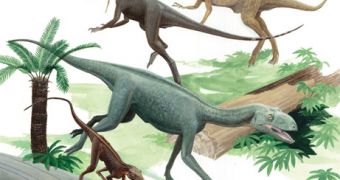Dinosaurs are regarded as the extreme beasts and totally dominating lords of their time, one of the highest stages of life's evolution. But fossils found in New Mexico suggest that dinosaurs required some time to get rid of their evolutionary cousins, the dinosauromorhs ("dinosaur like" reptiles) and turn into the dominant land animals on Earth, a gradual ascent rather than a quick takeover.
"Up to now, paleontologists have thought that dinosaur precursors disappeared long before the dinosaurs appeared. Now, the evidence shows that they may have coexisted for 15 or 20 million years or more." said co-author Kevin Padian of the University of California, Berkeley.
Dinosauromorphs looked like dinosaurs, but they had some primitive anatomical traits missing in true dinosaurs, like the lack of a hole in the pelvis for the femur. The two groups could have originated from a common ancestor, much like chimpanzees and humans or dogs and cats. But as their fossils had never been encountered together, many believed that dinosaurs out-competed rapidly the dinosauromorphs, filling their ecological niches.
"Dinosauromorphs that were known before our study were from a time when true dinosaurs never existed," said co-author Sterling Nesbitt of the American Museum of Natural History in New York City.
The novel fossils, found in the Hayden Quarry of New Mexico, turned the theory upside down. The site contained primitive theropod dinosaur fossils (the groups that later delivered birds, T. rex or feathered dinosaurs) and early dinosauromorphs, including some previously believed to have vanished by the late Triassic Period (235 to 200 million years ago).
"If there was any competition between the precursors and the dinosaurs, then it was a very prolonged competition," said co-author Randall Irmis, also of UC Berkeley.
One of the dinosauromorph fossils was a new species for science, named Dromomeron romeri, in the honor of Alfred Sherwood Romer, the paleontologist who first characterized dinosauromorphs in the early 1970s. This new species was 3-5 ft (0.9-1.5 m) long and bipedal.
"It shows that the Late Triassic was a time of unusually high diversity, something that we didn't realize at all before," said Paul Olsen of Columbia University, an expert on Late Triassic and Jurassic ecosystems. Paul Sereno, a paleontologist at the University of Chicago, thinks the new findings should not be extrapolated all over the world.
"It could be that dinosaurs replaced dinosauromorphs at different rates in different parts of Pangaea - the super-continent that existed at the time."
For example, in South America, the only other place where dinosauromorphs have been discovered, dinosaurs appeared to have eliminated them very rapidly. Anyhow, by the beginning of the Jurassic Period, 200 million years ago, dinosauromorphs were extinct and no one can explain what made primitive dinosaurs more successful.

 14 DAY TRIAL //
14 DAY TRIAL //